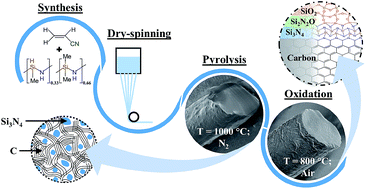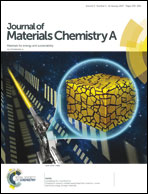A novel PAN/silazane hybrid polymer for processing of carbon-based fibres with extraordinary oxidation resistance
Abstract
A novel hybrid polymer made up of acrylonitrile (AN) and a commercial available oligosilazane (ML33) was developed as a precursor for the processing of carbon-based fibres with extraordinary intrinsic oxidation stability up to 800 °C. While polyacrylonitrile is used as the typical precursor for carbon fibres, a polysilazane derived SiCN ceramic phase should lead to improved oxidation resistance. Thermogravimetric analysis demonstrated that depending on the AN/ML33 ratio the weight loss during pyrolysis is drastically reduced up to 63% due to crosslinking reactions between both components, confirmed by NMR spectroscopy investigations. Unexpectedly, with increasing AN content in the starting composition the thermal treatment up to 1500 °C leads to a change from amorphous C/SiCN to C/Si3N4 nanocomposites confirmed by NMR, XRD and TEM measurements. The homogeneously distributed ceramic phase within the carbon matrix is responsible for the extraordinary intrinsic oxidation stability of this new type of carbon-based fibre.


 Please wait while we load your content...
Please wait while we load your content...